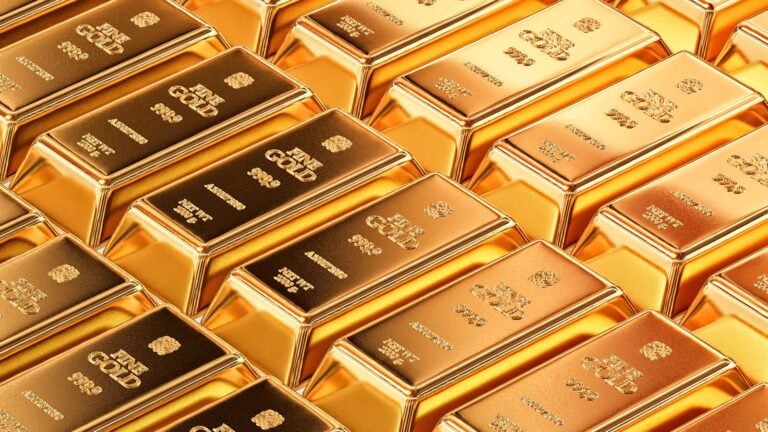Hello, Reader.
As a Smart Money reader, you have most likely heard me call gold the “Granddaddy of Portfolio Hedges” before.
The moniker comes from the price of gold often spending years going nowhere, before suddenly going somewhere… usually in a big way.
Often, the moment when gold decides to “go somewhere” is when you need it most, like when the stock market is going nowhere.
That tendency is what makes gold a venerable portfolio hedge.
However, if you needed another reason to add a gold hedge to your portfolio, the chart below might provide it.

You see, in order to service its titanic $34.6 trillion debt load, the federal government is spending more than $1 trillion per year in interest expense.
Historically, the yellow metal loves runaway government indebtedness.
So, in today’s Smart Money, we’ll explore why – and look at China as a case study.
Plus, we’ll decide whether gold is a worthy portfolio hedge right now.
Finally, I’ll share how to learn about an investment you won’t want to miss out on…
What’s Bad for the U.S. Is Good for Gold
Back to runaway government debt…
Rising indebtedness is not the only cause of this sorry state of the U.S. debt load. Rising interest rates are also to blame.
During the last three years, for example, the U.S. national debt has jumped 23% – from $28.0 trillion to $34.6 trillion. But during the same time frame, the average interest rate that the government pays to service its debt has more than doubled – from 1.50% to 3.28%.
You see, every time Federal Reserve Chairman Jerome Powell raises interest rates to slay inflation, he also plunges another dagger into the heart of the nation’s financial health.
Powell is not to blame, of course. He did not create the inflation he is trying to subdue. But the weapons of his trade are both primitive and toxic. Somewhat like chemotherapy, rising interest rates can help reduce the targeted inflation rate, but they can also create a slew of undesirable side effects, like the soaring cost of servicing the national debt.
That cost is real money.
Consider, for example, that if the average interest rate on U.S. Treasury debt were to return to the 1.50% level, the government’s annual interest expense would tumble to less than half its current level. Hypothetically, therefore, the steep drop in interest expense would “free up” $520 billion for government expenditures that could accomplish something more valuable than repaying creditors.
$520 billion isn’t chump change, not even for the United States. For perspective, that staggering sum would…
- Quadruple the U.S. transportation budget
- Nearly triple the veterans benefits budget
- Boost the defense budget by 63%
- Boost Social Security payouts by 38%
Alternatively, the government could simply use this “extra” $520 billion to reduce its debt load. Unfortunately, the interest expense line is heading up and to the right – and doing so quite rapidly.
That trend is bad news for our national economic health, but good news for gold.
Giving Thanks
As I said above, gold loves runaway government indebtedness.
Here’s why: Whenever a government borrows so heavily that it strains the confidence of its creditors, those creditors become less eager to lend. In such circumstances, they might…
- Reduce their lending
- Demand a higher rate of interest
- Reallocate some of their capital toward hard assets like gold
- All of the above.
China provides a fascinating and timely case study. For most of the last decade, the large Asian nation has been the largest foreign creditor to the United States. However, China’s appetite for U.S. Treasury securities has been waning steadily for years. Today, it holds 40% fewer Treasuries than it did in 2014 and has slipped behind Japan to become our second-largest foreign creditor.
Meanwhile, China has been ramping up its gold purchases. Based on official figures from the People’s Bank of China (PBoC) – which may not be entirely accurate – the country has boosted its gold reserves by 365% during the last 10 years – from $40 billion to $186 billion.
Importantly, China’s gold-buying activity has been gaining momentum recently. According to the World Gold Council, the PBoC reported the 17th straight monthly purchase in March.
During the first quarter alone, the PBoC purchased 27 tonnes of the shiny rock – equivalent to nearly 10% of yearly global gold production.
So, gold has definitely been saying “Thank you!” to China.
All in all, adding gold to your portfolio may not be the year’s best investment idea, but it probably isn’t the worst. We currently count one gold hedge in our Fry’s Investment Report portfolio – and I may add more soon.
Till then, however, we have another industry in our crosshairs. While gold may be thanking China, this sector is currently thanking Elon Musk…
As crazy as it sounds, artificial intelligence just got one step closer to ushering in “the next step in human evolution”… and minting new millionaires.
And it’s all thanks to Musk’s latest AI creation.
Regards,
Eric Fry

